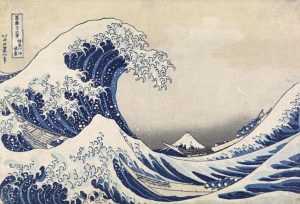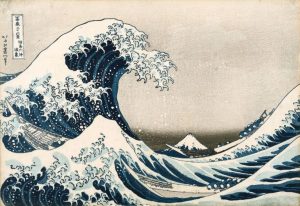The great wave off Kanagawa (The great wave) 1830–34
The great wave off Kanagawa (The great wave) 1830-34
By Wayne Crothers, Senior Curator, Asian Art, NGV

Katsushika Hokusai
The great wave off Kanagawa c.1830
from the Thirty-six Views of Mt Fuji series 1826-33
National Gallery of Victoria, Melbourne
The great wave off Kanagawa is one of Hokusai’s finest works and arguably the single most famous image in all Asian art. In addition to this work’s sheer graphic beauty, there is a compelling force in the contrast between wave and mountain. The horizon has been lowered to emphasise the monstrous wave towering above, its impending crash of water heightening a tension over the graceful lines of a diminutive Mt Fuji.
The dynamic composition creates a coexistence between human frailty and the power of nature. We see tiny fishermen huddled in their sleek crafts ride down one wave, dive straight into the next and endeavour to come out the other side. Every morning these swift boats, named oshiokuribune, transported fish to markets in Edo Bay from villages on the Bōsō Peninsula. The precision cutting of the line block required to create the tiny, lifelike tentacles of the wave, which have been cut only partially to articulate the water’s movement, is captivating. The use of printing blocks and colours is minimal with two shades of blue, a faint yellow, a gradation of grey on the horizon and a wash of grey over the sky to articulate splashes of water.

Katsushika Hokusai
The great wave off Kanagawa c.1830
from the Thirty-six Views of Mt Fuji series 1826-33
The Japan Ukiyo-e Museum, Matsumoto
Both the National Gallery of Victoria and the Japan Ukiyo-e Museum (JUM) prints of The great wave off Kanagawa can be identified as rare, early printings due to their sharp key line block impressions. As ukiyo-e prints were produced by hand, variations can be found in the applications of pigment. For example, the grey overprinting of the sky in the JUM’s print is darker than that in the NGV print, making the splashes of water more prominent. The tones of Prussian blue also appear darker in the JUM impression than in the NGV’s.
The two works were produced at the same time, from the same publisher’s studio, and separated at the time of sale. The JUM print was purchased during the Edo period by the Sakai family whose collection founded the JUM. The NGV print’s life was unknown until it was purchased by the American collector John Steward Happer during the late nineteenth century. Happer sold his famous collection at Sotheby, Wilkinson & Hodge, London, at a massive four-day auction on 26–29 April 1909, at which time The great wave off Kanagawa print was purchased by the Felton Bequest for the NGV, with four other prints from the Mt Fuji series, and sent to Melbourne.
